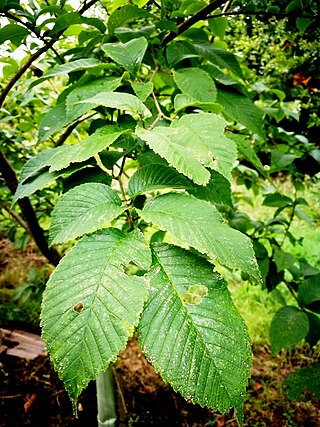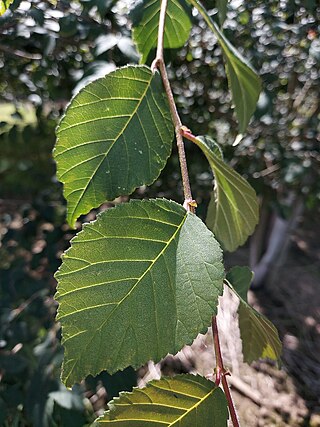Ulmus bergmannianaC.K.Schneid., commonly known as Bergmann's elm, is a deciduous tree found across much of China in forests at elevations of 1500–3000 m.

Ulmus laciniata(Trautv.) Mayr, known variously as the Manchurian, cut-leaf, or lobed elm, is a deciduous tree native to the humid ravine forests of Japan, Korea, northern China, eastern Siberia and Sakhalin, growing alongside Cercidiphyllum japonicum, Aesculus turbinata, and Pterocarya rhoifolia, at elevations of 700–2200 m, though sometimes lower in more northern latitudes, notably in Hokkaido.

Ulmus macrocarpaHance, the large-fruited elm, is a deciduous tree or large shrub endemic to the Far East excluding Japan. It is notable for its tolerance of drought and extreme cold and is the predominant vegetation on the dunes of the Khorchin sandy lands in the Jilin province of north-eastern China, making a small tree at the base of the dunes, and a shrub at the top.

Ulmus changii, occasionally known as the Hangzhou elm, is a small deciduous tree found across much of China in forests at elevations of up to 1800 m. Owing to its increasing scarcity, U. changii was added to the Hainan Province Protected Plants List in 2006.

Ulmus elongata, also known as the long raceme elm in the US, is a deciduous tree endemic to broadleaf forests in the eastern provinces of China.

Ulmus prunifoliaW. C. Cheng & L. K. Fu, the cherry-leafed elm, is a deciduous tree endemic only to the province of Hubei in central eastern China, where it is found at elevations of 1000–1500 m.
Ulmus chumlia is a small deciduous tree endemic to the Himalaya from the Kashmir to central Nepal, and the provinces of Yunnan, Sichuan and Xizang (Tibet) in China. It is found in broadleaf forest on mountain slopes at elevations of 1000–3000 m. Richens noted that the species appeared to be the same as that named by Grudzinskaya as Ulmus androssowii var. virgata, which she considered an intermediate between U. minor and U. pumila.

Ulmus harbinensisNie & Huang, also known as the Harbin elm, is a small elm found only in the province of Heilongjiang in the northeastern extremity of China, where it occurs in mixed forest.
Ulmus pseudopropinquaWang & Li, occasionally known in the United States as the Harbin spring elm, is a small deciduous tree found only in Heilongjiang, the northeasternmost province in China. The tree has not been studied comprehensively, and it has been speculated it may be a natural hybrid of Ulmus davidiana var. japonica and Ulmus macrocarpa.
Ulmus changii var. kunmingensisW. C. Cheng, occasionally referred to as the Kunming elm, is a Chinese tree endemic to montane forests at elevations of 600–1800 m in the provinces of Guangxi, Guizhou, Sichuan, and Yunnan.
Ulmus glaucescens var. glaucescens is a Chinese tree endemic to mountain slopes at elevations of 2000–2400 m in the provinces of Gansu, Hebei, Henan, Liaoning, Nei Mongol, Ningxia, eastern Qinghai, Shaanxi, Shandong, and Shanxi.
Ulmus glaucescens var. lasiocarpaRehder, named the hairy-fruited glaucescent elm in the United States, is a Chinese tree found along rivers and mountain slopes at elevations of 2500–2600 m in the provinces of Hebei, Henan, Liaoning, Nei Mongol, Ningxia, eastern Qinghai, and Shanxi.
Ulmus macrocarpa var. macrocarpaL. K. Fu is found on hillslopes and in valleys at elevations of 700–800 m in the Chinese provinces of Anhui, Gansu, Hebei, Heilongjiang, Henan, Hubei, Jiangsu, Jilin, Liaoning, Nei Mongol, eastern Qinghai, Shaanxi, Shanxi, Shandong. Beyond China it is also found in Korea, Mongolia, and Russia (Siberia).
Ulmus davidiana var. davidiana is variety of elm. The tree is restricted to the Chinese provinces of Hebei, Henan, Shaanxi and Shanxi.
Ulmus×mesocarpaM. Kim & S. Lee is a natural hybrid elm which is a cross of Ulmus macrocarpa with Japanese elm Ulmus davidiana var. japonica discovered on Seoraksan near the city of Sokcho on the eastern coast of South Korea. The tree is endemic to the provinces of Gangwon-do, Injegun, Bukmyeon, Yongdaeri, and Baekdamsa.

The hybrid elm cultivar Ulmus × hollandica 'Fastigiata' was first listed and described as Ulmus glabra fastigiata, a narrow-crowned elm with large smooth leaves, by Petzold and Kirchner in Arboretum Muscaviense (1864). C. Berndt of the Berndt Nursery, Zirlau, Schweidnitz, described an elm of the same name in Mitteilungen der Deutschen Dendrologischen Gesellschaft, that he had received in 1903 "from a renowned nursery in Holstein" as Ulmus montana fastigiata macrophylla. A tree of that name had been listed by Dieck in 1885 without description. Berndt reported that his U. glabra fastigiata was "easy to confuse with U. montana superba", a tree "known in the Magdeburg region as Ulmus praestans", a statement confirming that, like that cultivar, his tree was a form of U. × hollandica. Karl Gustav Hartwig who received specimens of U. praestans from Kiessling of the Magdeburg city nursery in 1908, concluded (1912) that U. glabra fastigiataKirchner was indistinguishable in leaf or habit from U. praestans. An U. campestris glabra fastigiataArb. Musc. [ = Kirchner] was distributed by the Hesse Nursery, Weener, Germany, in the 1930s, where it was listed separately from U. praestans.

The wych elm cultivar Ulmus glabra 'Nitida' [:'shining', an allusion to the smooth upper surface of the leaves], the smooth glossy-leaved wych, was described by Fries from specimens collected by P. C. Afzelius in 1841 on the island of Stora Karlsö, Sweden, as Ulmus montana nitida, in Novitiae Florae Suecicae: continuatio, sistens Mantissam III: 20 (1842). The Novitiae Florae Gotlandicae (1844) confirmed U. montana f. nitidaFr. as present on the islands of Stora Karlsö and neighbouring Lilla Karlsö off Gotland, Sweden, but did not report it from Gotland proper. A Stora Karlsö specimen from the Herbarium E. Fries is preserved in the Botanical Museum of Uppsala. The tree was listed by Rehder as U. glabraHuds. f. nitida (1915), a designation adopted by Krüssmann (1984), the latter copying Rehder's 'Norway' provenance error.







